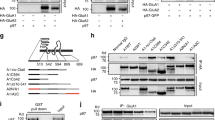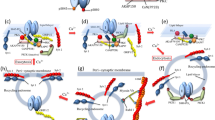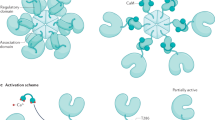Abstract
Although the function of the p42/p44 mitogen-activated protein (MAP) kinase pathway in long-term potentiation at hippocampal CA3–CA1 synapses has been well described, relatively little is known about the importance of the p38 MAP kinase pathway in synaptic plasticity. Here we show that the p38 MAP kinase pathway, a parallel signaling cascade activated by distinct upstream kinases, mediates the induction of metabotropic glutamate receptor-dependent long-term depression at CA3–CA1 synapses. Thus, two parallel MAP kinase pathways contribute to opposing forms of long-term plasticity at a central synapse.
This is a preview of subscription content, access via your institution
Access options
Subscribe to this journal
Receive 12 print issues and online access
$209.00 per year
only $17.42 per issue
Buy this article
- Purchase on Springer Link
- Instant access to full article PDF
Prices may be subject to local taxes which are calculated during checkout






Similar content being viewed by others
References
Cobb, M. H. MAP kinase pathways. Prog. Biophys. Mol. Biol. 71, 479–500 (1999).
York, R. D. et al. Rap1 mediates sustained MAP kinase activation induced by nerve growth factor. Nature 392, 622–626 (1998).
Bonni, A. et al. Cell survival promoted by the Ras-MAPK signaling pathway by transcription-dependent and -independent mechanisms. Science 286, 358–362 (1999).
Mao, Z., Bonni, A., Xia, F., Nadal-Vicens, M. & Greenberg, M. E. Neuronal activity-dependent cell survival mediated by transcription factor MEF2. Science 286, 785–790 (1999).
English, J. D. & Sweatt, J. D. Activation of p42 mitogen-activated protein kinase in hippocampal long term potentiation. J. Biol. Chem. 271, 24329–24332 (1996).
English, J. D. & Sweatt, J. D. A requirement for the mitogen-activated protein kinase cascade in hippocampal long term potentiation. J. Biol. Chem. 272, 19103–19106 (1997).
Winder, D. G. et al. ERK plays a regulatory role in induction of LTP by theta frequency stimulation and its modulation by beta-adrenergic receptors. Neuron 24, 715–726 (1999).
Sutton, K. G., McRory, J. E., Guthrie, H., Murphy, T. H. & Snutch, T. P. P/Q-type calcium channels mediate the activity-dependent feedback of syntaxin-1A. Nature 401, 800–804 (1999).
Martin, K. C. et al. MAP kinase translocates into the nucleus of the presynaptic cell and is required for long-term facilitation in Aplysia. Neuron 18, 899–912 (1997).
Xia, Z., Dickens, M., Raingeaud, J., Davis, R. J. & Greenberg, M. E. Opposing effects of ERK and JNK-p38 MAP kinases on apoptosis. Science 270, 1326–1331 (1995).
Oliet, S. H., Malenka, R. C. & Nicoll, R. A. Two distinct forms of long-term depression coexist in CA1 hippocampal pyramidal cells. Neuron 18, 969–982 (1997).
Dudek, S. M. & Bear, M. F. Homosynaptic long-term depression in area CA1 of hippocampus and effects of N-methyl-D-aspartate receptor blockade. Proc. Natl. Acad. Sci. USA 89, 4363–4367 (1992).
Mulkey, R. M. & Malenka, R. C. Mechanisms underlying induction of homosynaptic long-term depression in area CA1 of the hippocampus. Neuron 9, 967–975 (1992).
Mulkey, R. M., Endo, S., Shenolikar, S. & Malenka, R. C. Involvement of a calcineurin/inhibitor-1 phosphatase cascade in hippocampal long-term depression. Nature 369, 486–488 (1994).
Mulkey, R. M., Herron, C. E. & Malenka, R. C. An essential role for protein phosphatases in hippocampal long-term depression. Science 261, 1051–1055 (1993).
Kameyama, K., Lee, H. K., Bear, M. F. & Huganir, R. L. Involvement of a postsynaptic protein kinase A substrate in the expression of homosynaptic long-term depression. Neuron 21, 1163–1175 (1998).
Lee, H. K., Kameyama, K., Huganir, R. L. & Bear, M. F. NMDA induces long-term synaptic depression and dephosphorylation of the GluR1 subunit of AMPA receptors in hippocampus. Neuron 21, 1151–1162 (1998).
Bolshakov, V. Y. & Siegelbaum, S. A. Postsynaptic induction and presynaptic expression of hippocampal long-term depression. Science 264, 1148–1152 (1994).
Otani, S. & Connor, J. A. Requirement of rapid Ca2+ entry and synaptic activation of metabotropic glutamate receptors for the induction of long-term depression in adult rat hippocampus. J. Physiol. (Lond.) 511, 761–770 (1998).
Christie, B. R., Schexnayder, L. K. & Johnston, D. Contribution of voltage-gated Ca2+ channels to homosynaptic long-term depression in the CA1 region in vitro. J. Neurophysiol. 77, 1651–1655 (1997).
Wilk-Blaszczak, M. A. et al. The mitogen-activated protein kinase p38-2 is necessary for the inhibition of N-type calcium current by bradykinin. J. Neurosci. 18, 112–118 (1998).
Wu, L. G. & Saggau, P. Presynaptic inhibition of elicited neurotransmitter release. Trends Neurosci. 20, 204–212 (1997).
Cuenda, A. et al. SB 203580 is a specific inhibitor of a MAP kinase homologue which is stimulated by cellular stresses and interleukin-1. FEBS Lett. 364, 229–233 (1995).
Dudley, D. T., Pang, L., Decker, S. J., Bridges, A. J. & Saltiel, A. R. A synthetic inhibitor of the mitogen-activated protein kinase cascade. Proc. Natl. Acad. Sci. USA 92, 7686–7689 (1995).
Kullmann, D. M. & Siegelbaum, S. A. The site of expression of NMDA receptor-dependent long-term potentiation: New fuel for an old fire. Neuron 15, 997–1002 (1995).
Overstreet, L. S., Pasternak, J. F., Colley, P. A., Slater, N. T. & Trommer, B. L. Metabotropic glutamate receptor mediated long-term depression in developing hippocampus. Neuropharmacology 36, 831–844 (1997).
Fitzjohn, S. M., Kingston, A. E., Lodge, D. & Collingridge, G. L. DHPG-induced LTD in area CA1 of juvenile rat hippocampus: characterisation and sensitivity to novel mGlu receptor antagonists. Neuropharmacology 38, 1577–1583 (1999).
Gasparini, F. et al. 2-Methyl-6-(phenylethynyl)-pyridine (MPEP), a potent, selective and systemically active mGlu5 receptor antagonist. Neuropharmacology 38, 1493–1503 (1999).
Goda, Y. & Stevens, C. F. Synaptic plasticity: the basis of particular types of learning. Curr. Biol. 6, 375–378 (1996).
Bolshakov, V. Y. & Siegelbaum, S. A. Hippocampal long-term depression: arachidonic acid as a potential retrograde messenger. Neuropharmacology 34, 1581–1587 (1995).
Normandin, M. et al. Involvement of the 12-lipoxygenase pathway of arachidonic acid metabolism in homosynaptic long-term depression of the rat hippocampus. Brain Res. 730, 40–46 (1996).
Borsch-Haubold, A. G., Kramer, R. M. & Watson, S. P. Phosphorylation and activation of cytosolic phospholipase A2 by 38-kDa mitogen-activated protein kinase in collagen-stimulated human platelets. Eur. J. Biochem. 245, 751–759 (1997).
Hii, C. S. et al. Stimulation of p38 phosphorylation and activity by arachidonic acid in HeLa cells, HL60 promyelocytic leukemic cells, and human neutrophils. Evidence for cell type-specific activation of mitogen-activated protein kinases. J. Biol. Chem. 273, 19277–19282 (1998).
Weng, G., Bhalla, U. S. & Iyengar, R. Complexity in biological signaling systems. Science 284, 92–96 (1999).
Baudry, M., Arst, D., Oliver, M. & Lynch, G. Development of glutamate binding sites and their regulation by calcium in rat hippocampus. Brain Res. 227, 37–48 (1981).
Bolshakov, V. Y. & Siegelbaum, S. A. Regulation of hippocampal transmitter release during development and long-term potentiation. Science 269, 1730–1734 (1995).
Khokhlatchev, A. et al. Reconstitution of mitogen-activated protein kinase phosphorylation cascades in bacteria. Efficient synthesis of active protein kinases. J. Biol. Chem. 272, 11057–11062 (1997).
Bradford, M. M. A rapid and sensitive method for the quantitation of microgram quantities of protein utilizing the principle of protein-dye binding. Anal. Biochem. 72, 248–254 (1976).
Ferraguti, F. et al. Immunohistochemical localization of the mGluR1 metabotropic glutamate receptor in the adult rodent forebrain: evidence for a differential distribution of mGluR1 splice variants. J. Comp. Neurol. 400, 391–407 (1998).
Acknowledgements
We thank E. Frank for computer programs and suggestions, A. Moschin and M. Bergamaschi for secretarial assistance, C. Chiamulera and M. Corsi for support and discussions, and E. Odell for help in preparing figures. Supported by Glaxo Wellcome S.p.A. (F.B. and L.C.), the Whitehall Foundation (V.B.), and grants NS-29832 (S.A.S.) and DK-34128 (M.H.C.) from the U.S.P.H.S.
Author information
Authors and Affiliations
Corresponding author
Rights and permissions
About this article
Cite this article
Bolshakov, V., Carboni, L., Cobb, M. et al. Dual MAP kinase pathways mediate opposing forms of long-term plasticity at CA3–CA1 synapses. Nat Neurosci 3, 1107–1112 (2000). https://doi.org/10.1038/80624
Received:
Accepted:
Issue Date:
DOI: https://doi.org/10.1038/80624
This article is cited by
-
The role of pathological tau in synaptic dysfunction in Alzheimer’s diseases
Translational Neurodegeneration (2021)
-
Diversity and versatility of p38 kinase signalling in health and disease
Nature Reviews Molecular Cell Biology (2021)
-
Astrocytic p38α MAPK drives NMDA receptor-dependent long-term depression and modulates long-term memory
Nature Communications (2019)
-
Neurochemical and molecular mechanisms underlying the retrieval-extinction effect
Psychopharmacology (2019)
-
Depotentiation of Long-Term Potentiation Is Associated with Epitope-Specific Tau Hyper-/Hypophosphorylation in the Hippocampus of Adult Rats
Journal of Molecular Neuroscience (2019)



